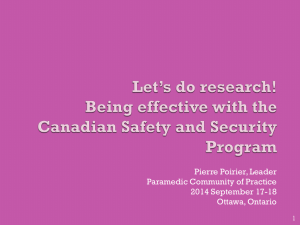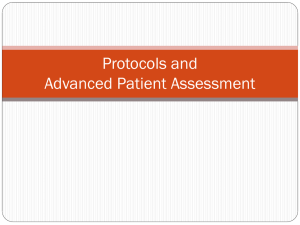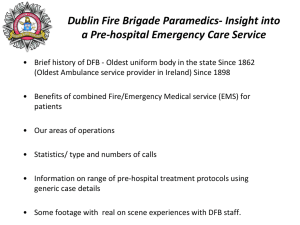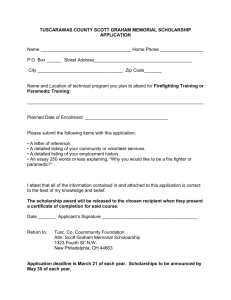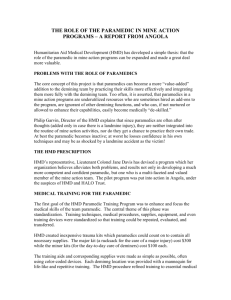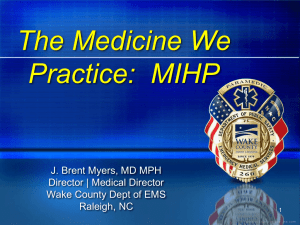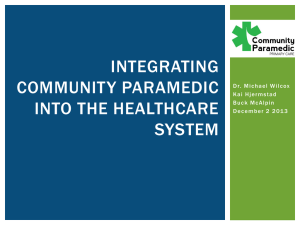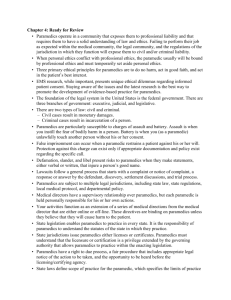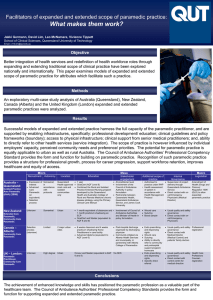paramedics-learn about - Health Education & Research Council of
advertisement
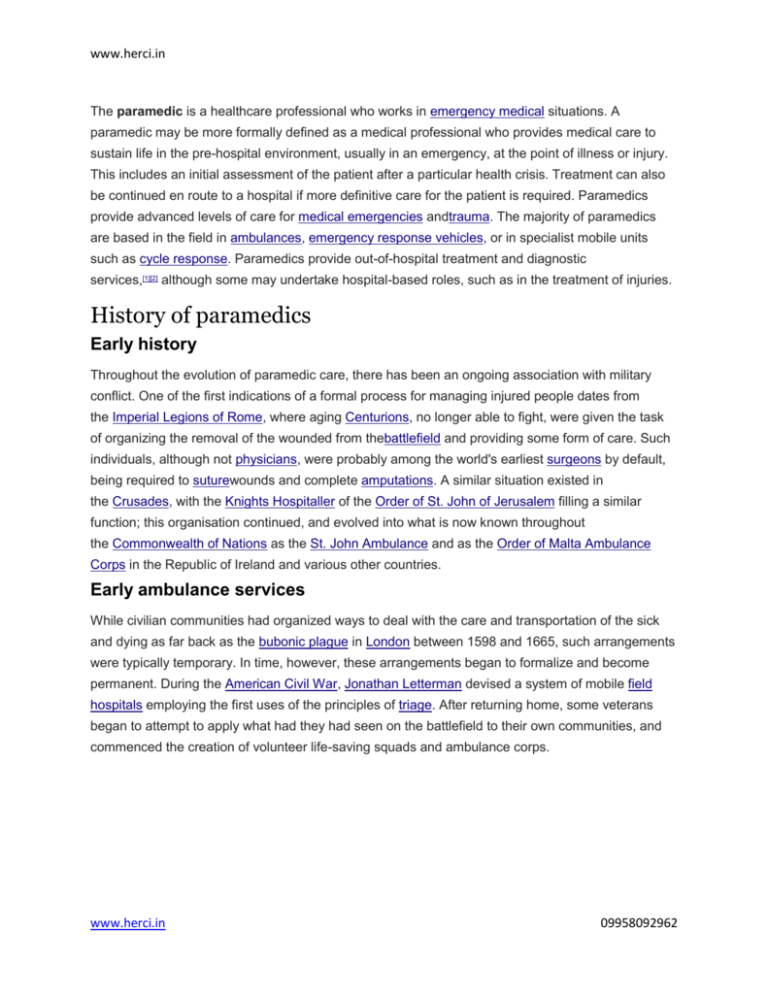
www.herci.in The paramedic is a healthcare professional who works in emergency medical situations. A paramedic may be more formally defined as a medical professional who provides medical care to sustain life in the pre-hospital environment, usually in an emergency, at the point of illness or injury. This includes an initial assessment of the patient after a particular health crisis. Treatment can also be continued en route to a hospital if more definitive care for the patient is required. Paramedics provide advanced levels of care for medical emergencies andtrauma. The majority of paramedics are based in the field in ambulances, emergency response vehicles, or in specialist mobile units such as cycle response. Paramedics provide out-of-hospital treatment and diagnostic services,[1][2] although some may undertake hospital-based roles, such as in the treatment of injuries. History of paramedics Early history Throughout the evolution of paramedic care, there has been an ongoing association with military conflict. One of the first indications of a formal process for managing injured people dates from the Imperial Legions of Rome, where aging Centurions, no longer able to fight, were given the task of organizing the removal of the wounded from thebattlefield and providing some form of care. Such individuals, although not physicians, were probably among the world's earliest surgeons by default, being required to suturewounds and complete amputations. A similar situation existed in the Crusades, with the Knights Hospitaller of the Order of St. John of Jerusalem filling a similar function; this organisation continued, and evolved into what is now known throughout the Commonwealth of Nations as the St. John Ambulance and as the Order of Malta Ambulance Corps in the Republic of Ireland and various other countries. Early ambulance services While civilian communities had organized ways to deal with the care and transportation of the sick and dying as far back as the bubonic plague in London between 1598 and 1665, such arrangements were typically temporary. In time, however, these arrangements began to formalize and become permanent. During the American Civil War, Jonathan Letterman devised a system of mobile field hospitals employing the first uses of the principles of triage. After returning home, some veterans began to attempt to apply what had they had seen on the battlefield to their own communities, and commenced the creation of volunteer life-saving squads and ambulance corps. www.herci.in 09958092962 www.herci.in German Red Cross paramedics training in 1931 These early developments in formalized ambulance services were decided at local levels, and this led to services being provided by diverse operators such as the local hospital, police, fire brigade, or even funeral directors who often possessed the only local transport allowing a passenger to lie down. In most cases these ambulances were operated by drivers and attendants with little or no medical training, and it was some time before formal training began to appear in some units. An early example was the members of the Toronto Police Ambulance Service receiving a mandatory five days of training from St. John as early as 1889.[3] Prior to World War I motorized ambulances started to be developed, but once they proved their effectiveness on the battlefield during the war the concept spread rapidly to civilian systems. In terms of advanced skills, once again the military led the way. During World War IIand the Korean War battlefield medics administered painkilling narcotics by injection in emergency situations, and pharmacists' mates on warships were permitted to do even more without the guidance of a physician. The Korean War also marked the first widespread use ofhelicopters to evacuate the wounded from forward positions to medical units, leading to the rise of the term "medivac". These innovations would not find their way into the civilian sphere for nearly twenty more years. Pre-hospital emergency care By the early 1960s experiments in improving care had begun in some civilian centres. One early experiment involved the provision of pre-hospital cardiac care by physicians inBelfast, Northern Ireland, in 1966.[4] This was repeated in Toronto, Canada in 1968 using a single ambulance called Cardiac One, which was staffed by a regular ambulance crew, along with a hospital intern to perform the advanced procedures. While both of these experiments had certain levels of success, the technology had not yet reached a sufficiently advanced level to be fully effective; for example, the Toronto portable defibrillator and heart monitor was powered by lead-acid car batteries, and weighed around 45 kilograms (99 lb). www.herci.in 09958092962 www.herci.in EMTs caring for a collapsed woman in New York In 1966, a report called Accidental Death and Disability: The Neglected Disease of Modern Society—commonly known as The White Paper—was published in the United States. This paper presented data showing that soldiers who were seriously wounded on the battlefields during the Vietnam War had a better survival rate than individuals who were seriously injured in motor vehicle accidents onCalifornia's freeways.[5] Key factors contributing to victim survival in transport to definitive care such as a hospital were identified as comprehensive trauma care, rapid transport to designated trauma facilities, and the presence of medical corpsman who were trained to perform certain critical advanced medical procedures such as fluid replacement and airway management. As a result of the The White Paper the US government moved to develop minimum standards for ambulance attendant training, ambulance equipment and vehicle design. These new standards were incorporated into Federal Highway Safety legislation and the states were advised to either adopt these standards into state laws or risk a reduction in Federal highway safety funding. The "White Paper" also prompted the inception of a number of emergency medical service (EMS) pilot units across the US including paramedic programs. The success of these units led to a rapid transition to make them fully operational. New York City's Saint Vincent's Hospital developed the United States' first Mobile Coronary Care Unit (MCCU) under the medical direction of William Grace, MD, and based on Frank Pantridge's MCCU project in Belfast, Northern Ireland.[when?] In 1967, Eugene Nagle, MD and Jim Hirschmann, MD helped pioneer the United States' first EKG telemetry transmission to a hospital and then in 1968, a functional paramedic program in conjunction with the City of Miami Fire Department. In 1969, the City of Columbus Fire Services joined together with the Ohio State University Medical Center to develop the "HEARTMOBILE" paramedic program under the medical direction of James Warren, MD and Richard Lewis, MD. In 1969, the Haywood County (NC) Volunteer Rescue Squad developed a paramedic program under the medical direction of Ralph Fleicher, MD. In 1969, the initial Los Angeles paramedic training program was instituted in conjunction with Harbor General Hospital under the medical direction of Michael Criley, MD and James Lewis, MD. In 1969, the Seattle "Medic 1" paramedic program was developed in conjunction with the Harborview Medical Center under the medical direction of Leonard, Cobb. The Marietta (GA) initial paramedic project www.herci.in 09958092962 www.herci.in was instituted in the Fall of 1970 in conjunction with Kennestone Hospital and Metro Ambulance Service, Inc. under the medical direction of Luther Fortson, MD.[6] The Los Angeles County and City established paramedic programs following the passage of The Wedsworth-Townsend Act in 1970. Other cities and states passed their own paramedic bills, leading to the formation of services across the US. Many other countries also followed suit, and paramedic units formed around the world. In the military, however, the required telemetry and miniaturization technologies were more advanced, particularly due to initiatives such as the space program. It would take several more years before these technologies drifted through to civilian applications. In North America, physicians were judged to be too expensive to be used in the pre-hospital setting, although such initiatives were implemented, and sometimes still operate, in European countries and Latin America. Public notability] While doing background research at Los Angeles' UCLA Harbor Medical Center for a proposed new show about doctors, television producer Robert A. Cinader, working for Jack Webb, happened to encounter "firemen who spoke like doctors and worked with them". This concept developed into the television series Emergency!, which ran from 1972 to 1979, portraying the exploits of this new profession called paramedics. The show gained popularity with emergency services personnel, the medical community, and the general public. When the show first aired in 1972, there were just six paramedic units operating in three pilot programs in the whole of the US, and the term paramedic was essentially unknown. By the time the program ended in 1979, there were paramedics operating in all fifty states. The show's technical advisor, James O. Page, was a pioneer of paramedicine and responsible for the UCLA paramedic program; he would go on to help establish paramedic programs throughout the US, and was the founding publisher of theJournal of Emergency Medical Services (JEMS). The JEMS magazine creation resulted from Page's previous purchase of the "PARAMEDICS International" magazine. Ron Stewart, was the show's medical director who was instrumental in organizing emergency health services in southern California earlier in his career during the 1970s, paramedic program in Pittsburgh EMS, substantial role in the founding of Toronto, Canada, paramedic program, and Nova Scotia, Canada, paramedic program. Evolution and growth Throughout the 1970s and 80s, the paramedic field continued to evolve, with a shift in emphasis from patient transport to treatment both on scene and en route to hospitals. This led to some services changing their descriptions from "ambulance services" to "emergency medical services". www.herci.in 09958092962 www.herci.in Bicycle paramedics in Los Angeles indicate the changing nature of the job The training, knowledge-base, and skill sets of both paramedics and emergency medical technicians (EMTs) were typically determined by local medical directors, what it was felt the community needed, and what was affordable. There were also large differences between localities in the amount and type of training required, and how it would be provided. This ranged from in-service training in local systems, through community colleges, and up to university level education. This emphasis on increasing qualifications has followed the progression of other health professions such as nursing, which also progressed from on the job training to university level qualifications. The variations in educational approaches and standards required for paramedics has led to large differences in the required qualifications between locations—both within individual countries and from country to country. Within the UK training is a two year course equivalent to a foundation degree. Comparisons have been made between Paramedics and Nurses; with Nurses now requiring degree entry (BSc) the knowledge deficit is large between the two fields. This has led to many countries passing laws to protect the title of "paramedic" (or its local equivalent) from use by anyone except those qualified and experienced to a defined standard. This usually means that paramedics must be registered with the appropriate body in their country, for example all paramedics in the United Kingdom must by registered with the Health Professions Council in order to call themselves a paramedic. In the United States, a similar system is operated by the National Registry of Emergency Medical Technicians (NREMT), although this is only accepted by forty of the fifty states. As paramedicine has evolved a great deal of both the curriculum and skill set has existed in a state of flux. Requirements often originated and evolved at the local level, and were based upon the preferences of physician advisers and medical directors. Recommended treatments would change regularly, often changing more like a fashion than a scientific discipline. Associated technologies also rapidly evolved and changed, with medical equipment manufacturers having to adapt equipment that worked adequately the hospital environment to be able to cope with the less controlled pre-hospital environment. www.herci.in 09958092962 www.herci.in Physicians began to take more interest in paramedics from a research perspective as well. By about 1990, the fluctuating trends began to diminish, being replaced by outcomes-based research. This research then drove further evolution of the practice of both paramedics and the emergency physicians who oversaw their work, with changes to procedures and protocols occurring only after significant research demonstrated their need and effectiveness (an example being ALS). Such changes affected everything from simple procedures, such as CPR, to changes in drug protocols. As the profession grew, some paramedics went on to become not just research participants, but researchers in their own right, with their own projects and journal publications. Changes in procedures also included the manner in which the work of paramedics was overseen and managed. In the early days medical control and oversight was direct and immediate, with paramedics calling into a local hospital and receiving orders for every individual procedure or drug. While this still occurs in some jurisdictions, it has become increasingly rare. Day-to-day operations largely moved from direct and immediate medical control to pre-written protocols or standing orders, with the paramedic typically seeking advice after the options in the standing orders had been exhausted. Canada[] Firefighters assist while Toronto EMS Paramedics load a patient into an ambulance. While the evolution of paramedicine described above is focused largely on the US, many other countries followed a similar pattern, although often with significant variations. Canada, for example, attempted a pilot paramedic training program at Queen's University,Kingston, Ontario, in 1972. The program, which intended to upgrade the then mandatory 160 hours of training for ambulance attendants, was found to be too costly and premature. The program was abandoned after two years, and it was more than a decade before the legislative authority for its graduates to practice was put into place. An alternative program which provided 1,400 hours of training at thecommunity college level prior to commencing employment was then tried, and made mandatory in 1977, with formal certification examinations being introduced in 1978. Similar programs occurred at roughly the same time in Alberta and British Columbia, with other Canadian provinces gradually following, but with their own education and certification requirements. Advanced Care Paramedics were not introduced until 1984, when Toronto trained its first group internally, before the process spread www.herci.in 09958092962 www.herci.in across the country. By 2010 the Ontario system involved a two year community college based program, including both hospital and field clinical components, prior to designation as a Primary Care Paramedic, although it is starting to head towards a university degree-based program (see, for example, the joint degree in paramedicine offered by Centennial College and the University of Toronto). Some services, such as Toronto EMS, continue to train advanced care paramedics internally. United Kingdom[] In the United Kingdom, ambulances became largely municipal services shortly after the end of World War II. Training was frequently conducted internally, although national levels of coordination led to more standardization of staff training. As of 2010 public ambulance services were operated by regional entities, most often trusts, under the authority of theNational Health Service, with significant standardization of training and skills. The UK model utilizes two levels of ambulance staff, internally trained Ambulance Technicians, which are similar to EMTs in the US, and paramedics with advanced life support skills. Initially paramedics were mainly trained internally, with experienced ambulance technicians often progressing to the role of paramedic. Increasingly, however, university qualifications are being expected for paramedics, with the entry level being an Honours Bachelor of Science degree in Pre-Hospital or Paramedic Care. Some British paramedics have gone on to become Paramedic Practitioners, a role that practices independently in the pre-hospital environment in a capacity similar to that of a nurse practitioner, but with more of an acute care orientation. Current practice[] In the United States, paramedic training is considered vocational. The disparity of educational requirements and lack of an academic degree contribute to overall lower wages and less respect amongst other allied health care providers. Paramedic education programs typically follow the US Department of Transportation’s Emergency Medical Technician-Paramedic: National Standard Curriculum. While many regionally accred colleges and universities offer paramedic programs only a handful require a formal degree component prior to completion. Course minimum required hours vary from state to state but range between 700 – 1300 didactic and clinical hours. Calendar length can vary from between six months to upwards of two years. Paramedicine, however, continues to grow and evolve into a formal profession in its own right, complete with its own standards and body of knowledge, and in many locations paramedics have formed their own professional bodies. The early technicians with limited training, performing a small and specific set of procedures, has become a role requiring a foundation degree in countries such as Australia, South Africa, and the UK, and increasingly in Canada. Structure of employment[] See also: Paramedics by country www.herci.in 09958092962 www.herci.in Firefighter paramedics assist a simulated burn victim during a US Navymass casualty drill Paramedics are employed by a variety of different organizations, and the services provided by paramedics may occur under differing organizational structures, depending on the part of the world. A new and evolving role for paramedics involves the expansion of their practice into the provision of relatively basic primary health care and assessment services. Some paramedics have begun to specialize their practice, frequently in association with the environment in which they will work. Some early examples of this involved aviation medicine and the use of helicopters, and the transfer of critical care patients between facilities. While some jurisdictions still use physicians, nurses, and technicians for transporting patients, increasingly this role falls to specialized senior and experienced paramedics. Other areas of specialization include such roles as tactical paramedics working in police units, marine paramedics, hazardous materials (Hazmat) teams, Heavy Urban Search and Rescue, and paramedics on offshore oil platforms, oil and mineral exploration teams, and in the military. The majority of paramedics are employed by the municipal emergency medical service for their area, although this employer could itself be working under a number of models, including a specific autonomous public ambulance service, a fire department, a hospital based service or a private company working under contract. There are also many paramedics who volunteer for backcountry rescue teams, small town rescue squads, and the like. The provision of municipal ambulance services, and paramedics, can vary by area, even within the same country or state. For instance, in Canada, the province of British Columbia operates a province-wide service (the British Columbia Ambulance Service) whereas in Ontario, the service is provided by each municipality, either as a distinct service, linked to the fire brigade, or contracted out to a third party. Paramedic skills[] Common skills[] While there are varying degrees of training and expectations around the world, a general set of skills shared by essentially all paramedics and EMTs includes: Advanced cardiac life support, or ACLS, treats areas involving cardiac injury or compromise; the most common is cardiac arrest. Since the heart and nervous system begin to degrade in as little as 4-6 minutes, early recognition and treatment in the prehospital setting is very effective in life saving treatments. Using many devices and treatment modalities, such as Cardiac Monitors, Defibrillators, and cardiac medications, the chief objective is to stop and reverse the effects of lack of cardiac output. Spinal injury management, including immobilization and safe transport www.herci.in 09958092962 www.herci.in Fracture management, including assessment, splinting, and use of traction splints where appropriate Obstetrics, including assessment, assisting with uncomplicated childbirth, and recognition of and procedures for obstetrical emergencies such as breech presentation, cord presentation, and placental abruption Management of burns, including classification, estimate of surface area, recognition of more serious burns, and treatment Advanced airway management techniques including surgical airways. Triage of patients in a mass casualty incident Assessment and evaluation of general incident scene safety Effective verbal and written reporting skills (charting) Routine medical equipment maintenance procedures Routine radio operating procedures Emergency vehicle operation Medications administered[] Paramedics in most jurisdictions administer a variety of emergency medications. The specific medications they are permitted to administer vary widely, based on local standards of care and legal restrictions, and physician or medical director preferences. For an accurate description of permitted drugs or procedures in a given location, it is necessary to contact that jurisdiction directly. A representative list of medications may commonly include: A paramedic preparing an intravenous infusion for a patient Analgesic medications such as aspirin, ketorolac and paracetamol, used to relieve pain or decrease nausea and vomiting Narcotics like morphine, pethidine, fentanyl, and dilaudid, used to treat severe pain, such as with burns and fractures Adenosine, calcium channel blockers Diltiazem and Verapamil used to slow down excessively high heart rates Parasympatholytic drug such as Atropine, used to speed up slow bradycardia heart rates www.herci.in 09958092962 www.herci.in Sympathomimetics[7] such as dopamine, dobutamine, norepinephrine, and epinephrine used for severe hypotension (low blood pressure), cardiogenic shock and septicemia. D50W (a solution of 50% dextrose in water), used to treat hypoglycemia (low blood sugar) Sedatives like midazolam, lorazepam, and etomidate, used to reduce the irritability or agitation of patients Paralytics such as succinylcholine, rocuronium, and vecuronium, used when an emergency procedure such as rapid sequence intubation (RSI) is required Antipsychotics like haloperidol or ziprasidone, used to sedate combative patients Respiratory medications such as salbutamol, Ipratropium bromide and methylprednisolone, used to treat conditions such as asthma and acute bronchitis Cardiac medications such as nitroglycerin, aspirin, and morphine, fentanyl used to treat cardiac ailments such as angina and heart attacks Antiarrhythmics such as amiodarone, lidocaine and magnesium sulfate used to treat cardiac arrhythmias such as ventricular tachycardia and ventricular fibrillation Antiemetics such as promethazine or ondansetron used for nausea and vomiting Naloxone used to treat opioid drug overdose and flumazenil Skills by certification level[] As described above, many jurisdictions have different levels of paramedic training, leading to variations in what procedures different paramedics may perform depending upon their qualifications. Three common general divisions of paramedic training are the basic technician, general paramedic or advanced technician, and advanced paramedic. Common skills that these three certification levels may practice are summarized in the table below. The skills for the higher levels automatically also assume those listed for lower levels. Paramedic Advanced EMT Treatmen Emergency Medical Technician t issue (EMT) (Paramedic Australia) (Primary Care Paramedic Canada) Airway Assessment, manual Tracheal intubation, (Intensive Care Paramedic Aus) (Advanced Care Paramedic Canada) Rapid sequence managem repositioning, combitube,laryngeal nasopharyngeal intubation, induction, surgical ent tube, oropharyngeal andnasophar advanced airway management, airway procedures yngeal airway adjuncts, manual Surgical/needle including needle removal of obstructions, airways ETT, LMA, cricothyrotomy, suctioning and combitube, deep suctioning, surgical www.herci.in 09958092962 www.herci.in use of Magill forceps cricothyrotomy Pulse oximetry, active oxygen Use of mechanical symmetry, skin color), obstructed administration byendotracheal transport airway maneuver, tube or other device using BVM, ventilators, active passive oxygenadministration by side stream, or inline end tidal oxygen nasal canula, rebreathing and carbon dioxide,capnography administration by Breathing Assessment (rate, effort, non-rebreathing mask, active surgical airway, oxygen administration by bag decompression of valve mask (BVM) and Demand- chest cavity using Valve Resuscitator. needle or valve device (needle thoracotom y)! Intercostal chest drain insertion, RSI Circulatio Assessment of pulse (rate, Ability to interpret assessment Intravenous plasma n rhythm, volume), blood pressure, findings in terms of levels volume skin color, and capillary refill, of perfusion, intravenous fluid expanders, blood patient positioning to enhance replacement, use transfusion, intraos circulation, recognition and control of vasoconstriction drugs seous of hemorrhage of all types using (IO) cannulation(pl direct and indirect acement of needle pressure, tourniquets, and into marrow space obtaining intravenous access of a large bone), central venous access (using central venous catheter by way of external jugular or subclavian), hemodynamic monitoring of previously placed pulmonary artery catheters, management of previously placed balloon pumps www.herci.in 09958092962 www.herci.in Cardiac Cardiopulmonary resuscitation, Dynamic resuscitation including Expanded drug arrest airway management, manual intubation, drug administration ventilation with BVM,automatic (includes antiarrhythmics), ECGi ECG interpretation external defibrillator nterpretation (may be limited to (twelve-lead), three-lead), semi-automatic manual defibrillator, and/or manual synchronized defibrillator,cardioversion, and mechanical or external cardiac pacing chemical therapy options, cardioversion, exter nal pacing of the heart Cardiac Placement but not interpretation Basic ECG monitoring Twelve or Monitorin of Cardiac Eighteen-lead ECG g monitoring and monitoring ECGs electrodes. interpretation Drug Oral, nebulized, limited list of drugs endotracheal tube, administr and intramuscular injection of a for Intramuscular,subcutaneous, rectal tube, infusion ation intravenous injection limited list of drugs pump (bolus),intravenous drip, transdermal and intraosseo us Drug Low-risk and immediate Considerable expansion of Significantly types requirements, e.g., aspirin and permitted drugs to include any expanded drug list, drug in a practicing protocol or any drug in the ordered online, including paramedic's permitted nitroglycerin (chest pain), oral glucose andglucagon (diabetes), epinephri analgesics (may include protocol or ne (allergic narcotics), antiarrhythmics, approved by online reaction), salbutamol (asthma), major cardiac resuscitation order. The most sometimesnaloxone (narcotic drugs, bronchodilators,vasocons common additional overdose) trictors, sedatives are normally drugs are often restricted to treatment of status paralytics and epilepticus sedatives for use in rapid sequence induction as well as some less often used drugs like heparin. In some www.herci.in 09958092962 www.herci.in jurisdictions advanced levels of paramedics are permitted to administer any drug, as long as they are familiar with it, and may have limited authority to prescribe Patient Basic physical assessment, vital More detailed physical Interpretation of lab assessme signs, history of general and assessment and results, nt history,auscultation, interpretation of interpretation of assessment chest x-rays, findings, ECG limited interpretation, glucometry, interpretation of capnography, pulse oximetry cranial CT scan, current condition limited diagnosis (e .g. rule out fracture usingOttawa ankle rules), ultrasonogra phy[8] Wound Assessment, control of bleeding, Wound cleansing, managem application of pressure dressings wound closure ent with butterfly and other types of dressings stitches, suturing Medicolegal authority[] The medicolegal framework for paramedics is highly dependent on the overall structure of emergency medical services in the territory where they are working. www.herci.in 09958092962 www.herci.in Paramedics load an injured woman into an air ambulance after a head-on collision in the Kawartha Lakes region of Ontario, Canada In many localities, paramedics operate as a direct extension of a physician medical director and practice as an extension of the medical director's license. In the United States, a physician delegates authority under an individual state's Medical Practice Act. This gives a paramedic the ability to practice within limited scope of practice in law, along with state DOH guidelines and medical control oversight. The authority to practice in this manner is granted in the form of standing orders (protocols) (off-line medical control) and direct physician consultation via phone or radio (online medical control). Under this paradigm, paramedics effectively assume the role of out-of-hospital field agents to regional emergency physicians, with independent clinical decision. In places where paramedics are recognized health care professionals registered with an appropriate body, they can conduct all procedures authorised for their profession, including the administration of prescription medication, and are personally answerable to a regulator. For example, in the United Kingdom, the Health and Care Professions Council regulates paramedics and can censure or strike a paramedic from the register. In some cases paramedics may gain further qualifications to extend their status to that of a paramedic practitioner, which provides the right to prescribe, rather than just administer, medication. In some areas, paramedics are only permitted to practice many advanced skills while assisting a physician who is physically present, except for immediately life-threatening emergencies. In entertainment[] Emergency! was a popular 1970s television series which centered on the work of paramedics in the Los Angeles County Fire Department, and the staff at the fictional Rampart Emergency Hospital. Emergency! has been widely cred with inspiring many municipalities in the United States to develop their own paramedic programs, and acted as an inspiration for many individuals to enter the fields of emergency medicine. The show rated well for its entire production run (1972–79), as well as in syndicatedreruns, and inspired a related cartoon series. Mother, Jugs & Speed is a 1976 comedy film, starring Bill Cosby, Raquel Welch, and Harvey Keitel. The film depicts a private ambulance company struggling to survive in Los Angeles, and www.herci.in 09958092962 www.herci.in gives an indication of the state of the ambulance industry just prior to its increased professionalism. Trauma Center is a 1983 American television medical drama focussing on the McKee Hospital Trauma Center, and two paramedics who had to rescue or save injured people before delivering them to the trauma center. Casualty is a long-running British BBC television series (1986–present), depicting the fictional Holby City Hospital's Accident and Emergency Department, and the related paramedics. Casualty has inspired the spin-off series, Holby City, and a number of made-fortelevision films. Paramedics is a 1988 American comedy film focussing on a group of paramedics in a US city. Paramedic: On the Front Lines of Medicine, is a 1988 autobiographical account of a paramedic's first year on the job by Peter Canning. A sequel, Rescue 471: A Paramedic's Stories was released in 2000. Bringing Out the Dead is a 1999 American drama film, directed by Martin Scorsese and starring Nicolas Cage, showing forty-eight hours in the life of a burnt-out paramedic in New York's Hell's Kitchen. The film is based on the novel of the same name by Joe Connelly, a former New York City paramedic. Paramedics is an American reality television show that originally screened from 1999 to 2001, and now runs intermittently on the Discovery Health Channel. The show features the life and work of emergency medical squads in major urban centers in the United States. Third Watch (1999–2005) is an American television drama, parts of which focused on the firefighters and paramedics of the New York City Fire Department. Shinjuku Punk Rescue Ambulance is a 2000 Japanese comedy drama TV series which aired on Nippon Television in Japan. The story is about two young Tokyo Fire Department ambulance technicians at Shinjuku West District and working with medical staff of Juniso Hospital. The show is also demonstrating how to deal various emergency scenario with first aid techniques at the ending of each episode. Into the Breach: A Year of Life and Death with EMS is a 2002 book written by J. A. Karam, focussing on real-life stories of paramedics, emergency medical technicians, and heavy-rescue specialists fighting to control trauma and medical emergencies. Saved is a 2006 medical television drama centered on a fictional paramedic, his partner, and their chaotic lives on and off the job. Black Flies is a 2008 American novel written by Shannon Burke, based on his experiences working as a paramedic in Harlem, New York. In the NBC's sci fi drama Heroes (2006, 2010), the character Peter Petrelli used his abilities to save fifty-three people working as a paramedic. www.herci.in 09958092962 www.herci.in Code Blue: Doctor-Heli (2008, 2010) is a Japanese television medical drama aired on Fuji TV Network. It is centered on the lives and works of flight physician trainees with air ambulance program of the fictional Shoyo University Hokubu Hospital Emergency Center. Trauma is a 2009–10 American television drama series focusing on a group of San Francisco Fire Department paramedics working in conjunction with the fictional trauma center of San Francisco City Hospital. Recruits: Paramedics is an Australian television series airing on Network Ten, depicting the work of trainee paramedics recently employed with the Ambulance Service of New South Wales. Denise Sherwood, from "Army Wives" was a paramedic, having been a nurse beforehand and a 911 dispatcher later on. F.S.D. is 2011 Hong Kong action-drama TV series which co-produced by RTHK and Hong Kong Fire Service Department. It is focused on the work and lives of ambulancemen and firemen in the Hong Kong Fire Service Department. 2nd episode: "Caring with Love" and 5th episode: "Call for Duty" are centered on the ambulancemen and paramedics particularly. Sofia's Last Ambulance (2012) is a feature-length documentary by Ilian Metev about a dedicated ambulance crew in Sofia, Bulgaria. The film premiered in Cannes in 2012. Elite Brigade is 2012 Hong Kong action-drama TV series which also co-produced by RTHK and Hong Kong Fire Service Department after pervious series "F.S.D." succeed in 2011. The story carries on to tell the work of ambulancemen and firemen in the Hong Kong Fire Service Department. 3rd episode: "First Responders" is centered on the ambulancemen and paramedics who facing a double-decker bus crash during rush hours with mass victims on scene. Trauma Team, a surgery video game for the Nintendo Wii, features a playable paramedic named Maria Torres whose playstyle centers around managing and stabilizing multiple accident victims at once. In the game Metal Gear Solid 3, Dr. Clark nicknamed Para-medic dreams of creating a unit of medics able to parachute down to an emergency location. Junior Paramedics is a British television series that was first broadcast on BBC Three on 27 February 2014. The series follows paramedics on a six week placement with East Midlands Ambulance Service. www.herci.in 09958092962

